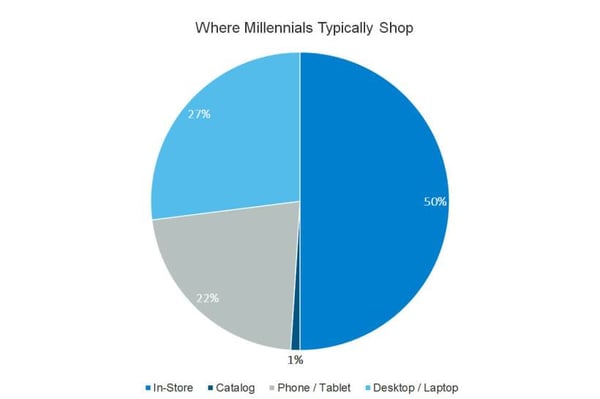Millennials—a demographic often labeled as digitally savvy and currently in their mid-teens or early 30s—probably mean an infinite number of things to you as a furniture retailer.
To some of you, they’re a mystery and to others, they’re an immensely important part of your future merchandising and marketing strategy. But to all furniture retailers who want a significant stake in this $100 billion vertical, millennials are a massive opportunity you do not want to overlook.
It’s time now more than ever to craft omnichannel experiences for perhaps the most influential demographic within the furniture category—for a lot of the industry’s big players, it’s certainly top-of-mind. In the effort to compete with the retailers who have won over millennials already, we’ve elaborated on four notable statistics to help you create a clear-cut strategy for winning over the millennial furniture shoppers.
Nearly 29% of the U.S. population are millennials.
Said another way, millennials are a huge contingent of the U.S. population. Not only are there a lot of millennials in the U.S., but they also have tremendous purchase power and won’t spend their money on just any product from any brand. According to Accenture, millennials spend about $600 billion each year and are projected to spend $1.4 trillion annually while representing 30% of retail sales in 2020.
As a demographic that is at the forefront of today’s digital revolution, know that you will need to readjust your marketing and merchandising strategies to meet their preferences. But reaching such a big part of the population isn’t easy, especially when their needs and demands are specific to an omnichannel shopping experience.

50% of the time, millennials are shopping in-store.
Although millennials are highly associated with digital engagement, let’s debunk the myth that they will never step inside a storefront again.
In an industry like furniture, there’s a lot of native advantages to offering in-store experiences—more specifically, experiences that aren’t limited to superior touch-and-feel experiences or more efficient frameworks for delivery. Accenture found that 68% of millennials demand a seamless online to in-store experience and will not settle for anything less. However, these experiences have to do with more than just the physical products in your stores. Mobile experiences, in-store environment, store associate interactions and more will all influence whether or not a millennial prefers shopping in your store.
But let’s not forget how millennials end up walking into your stores in the first place. They’ll most likely receive information about products and brands online, and more often they’ll find it on mobile. According to Furniture|Today, 47% of millennial shoppers shop online, but buy at brick-at-mortar stores, and their online shopping behavior includes reading product ratings and reviews, searching for the best value, and comparing pricing before deciding which stores to visit.
Furniture retailers can flourish by unifying online and brick-and-mortar messaging and resources. Invest in technology that can benefit both of these channels. At Blueport, we offer features like Store Sync, localized marketing and merchandising, and more to sync these two channels and offer millennials exactly what they need to purchase your products.
Millennials prefer 1-3 marketing emails every month.
It’s no question that a lot of millennials find out about your key promotions and marketing initiatives via emails – 95% of millennials want brands to court them actively by sending them coupons via email. However, millennials don’t enjoy being bombarded with too many last-minute door-buster messages.
Not only should you focus on your email marketing strategy as a whole, but really tap into your loyalty program emails targeting millennials. While some say millennials aren’t loyal, their behavior begs to differ. Millennials are extremely loyal to brands that deliver personalized, targeted promotions and discounts. According to SmarterHQ, sale notifications for a previously carted item, previously browsed items/categories and product recommendations based on a shopper’s interests are all important emails for this segment.
Long story short: information is key to selling. Provide millennials with the information they need to complete a purchase, and they will buy.
Differentiating your entire email marketing strategy specifically for millennials may seem like a lot of work for just one target group, but you can always start out with Blueport’s four critical components to an effective email marketing strategy.
85% of online adults under 30 are using a smartphone.
There’s a significant opportunity to win over millennials when it comes to smartphones with mobile being the best channel to catch their attention. In an era of mobile-first website development, it’s paramount to keep mobile top-of-mind when considering all aspects of your brand.
Your website and marketing channels must all be mobile-optimized and responsive for shoppers to be able to view your content wherever they may be. This is important for your omnichannel experience as well, with 96% of millennials using their mobile devices in-stores to compare and shop products then complete an in-store purchase. Furthermore, according to Forbes, 80% of their purchases are influenced by price, meaning your website must be legible on a mobile device when millennials are comparing your prices to a competitor’s prices while shopping in-store.
Platforms like Blueport with responsive design will ensure a seamless shopping experience wherever millennials are looking at your site from.
By understanding the behavioral tendencies of millennials, begin to hone in on new ways you can connect this critical purchasing group to your brand. And as you begin forming strategies and ways to capture the millennial opportunity, know that you already have a leg up on pureplay retailers like Amazon and Wayfair: your brick-and-mortar stores.
Using your established storefront presence paired with strong technology, you can create the exact experiences that millennials crave. And with a partner like Blueport, we can help you build the best strategies to resonate with this important audience in the furniture space.




